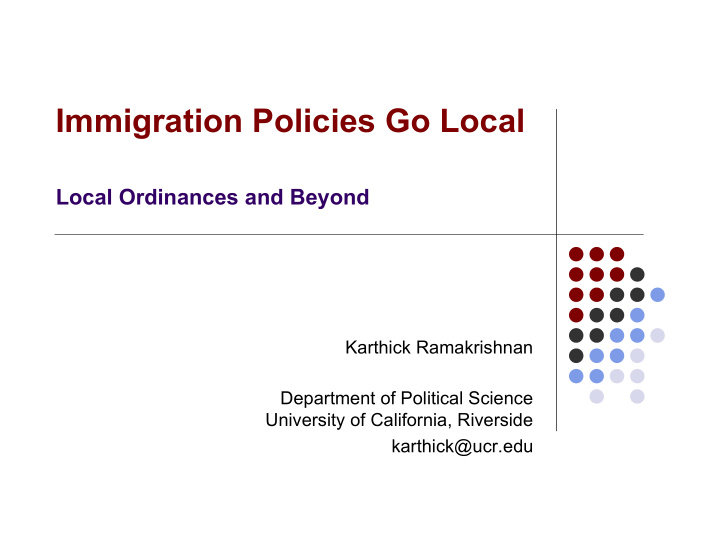



Immigration Policies Go Local Local Ordinances and Beyond Karthick Ramakrishnan Department of Political Science University of California, Riverside karthick@ucr.edu
Since 2003… Immigration Politics Definitely Local • Not DC • Protests, Anti-immigrant groups • Policies: Restrictionist as well as permissive • Contrast with 2003
Local Government Policies and Practices Language access Translated documents Interpreters Knowledge about immigrant community Needs and issue priorities Community organizations Leadership development Appointment to boards and commissions Services and regulation Housing, law enforcement, education, health
Examples of Ordinances Landlords (Hazelton and copycats) Business contracts with city (Elsemere, DE) Business licenses denied (Hazelton et al.) Local police to facilitate deportations English as official language City IDs for all residents (New Haven, CT) “Sanctuary” ordinances (St. Louis, MO) Construction / funding of day labor centers
Restrictionist Local Ordinances
Descriptive Findings: Pro or Con?
Descriptive Findings: Pro or Con?
What Explains It? Negative externalities from rapid demographic change Spanish language dominance Wage competition Overcrowding Group political power Protests and politicization, possible backlash Electoral power of Latino citizens Partisanship / Ideology of electorate
Merging Data & Hypothesis Testing Various databases, confirmation via phone calls Immigrant Protests Census data Recency of migration, growth of Latinos Relative poverty rates Linguistic isolation Overcrowded housing Jobs in agriculture, construction Presidential vote choice State-level factors
Descriptive Stats: Politics and Power Restrictionist No Proposal “Pro” % with Republican majority 69 70 26 in county*** Latino share of 10.8 6.6 21.1 population*** Latino share of citizens*** 7.9 5.7 18.0 Any pro-immigration 12 1 54 protest*** (% likelihood) % employed in agriculture 0.9 3.1 0.9
Demographic Disruptions Restrictionist No Proposal “Pro” Growth in Latino 258.2 177.7 59.4 population (%), 1990- 2000* % of immigrants arrived 26.1 16.6 29.5 since 1995 % of Spanish linguistic- 2.4 1.3 5.3 isolated households*** % of households 2.0 1.6 5.9 overcrowded***
Poverty, Economic Competition Restrictionist No Proposal “Pro” Black poverty rate 23.0 13.2 23.5 White poverty rate 9.4 10.7 10.7 Latino poverty rate 21.0 15.1 22.8 Population*** 71,939.3 7,015.5 807,151.7
Which Factors Most Important? Need for regression analysis Corrections Rare events modeling County data on partisanship
Predicting Restrictionist Proposals
Predicting Restrictionist Passage
Predicting Pro-Immigrant Proposals
Predicting Pro-Immigrant Passage
What Explains It? Partisanship / Ideology of electorate Group political power Protests Interest groups (agriculture) Latino citizens Local Demographic Change Language/Culture Economic Competition / Poverty
Caveats and Concerns State policies controlled with dummy variables More systematic classification pending MPI report But, seems to hold even with particular states such as Pennsylvania How to model state policy process and local policy process? What about city-level party data?
City level party data
Next Steps In-depth studies of representative and atypical cases Beyond ordinances to daily practices Survey of municipal governments California in 2003 (www.ppic.org) Nationwide in 2007 (500-1000 cities)
Recommend
More recommend